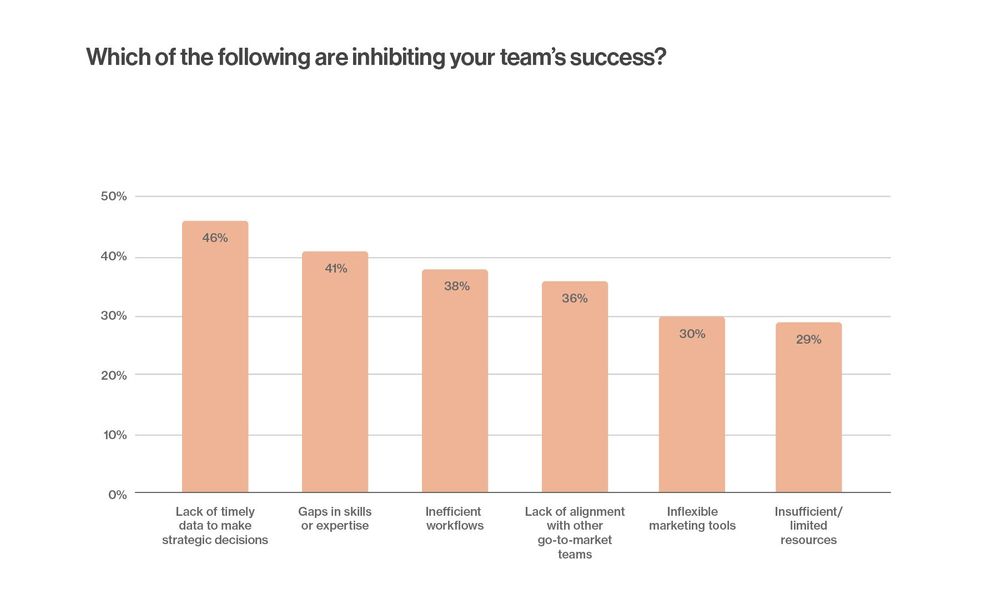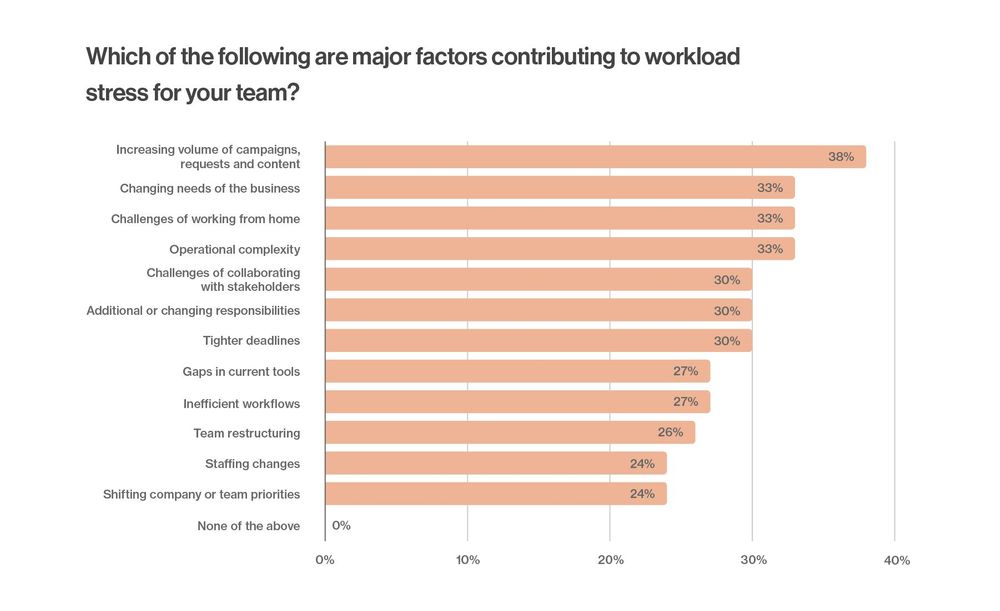In a lot of ways, marketing is getting harder. If you look back in time—even five, ten years—it’s clear that the work of marketing has fundamentally changed. Today, you’d be hard-pressed to find a team that isn’t producing more campaigns, on shorter timelines, to meet more aggressive business goals. In fact, 80% of marketing leaders say the volume of campaigns, requests, and content has increased over the last year.
To tackle that volume, marketing teams are investing in content and campaigns. A report from Accenture estimated that enterprises spend between $150M and $250M annually on content-related activities alone. And more budget, you’d think, would make those tasks more manageable.
So if investment in content and campaigns is this high: why do so many marketers still feel like they’re drowning? We asked 300 marketing leaders to share their take in our Marketing Trends Report. Here’s what we found:
Marketing leaders are data rich (but information poor)
We live in the age of big data: one where we have access to way more information than we could ever reasonably use.
And in marketing, data steers the ship. It’s the benchmark marketers use to identify audiences, analyze campaign performance, and figure out which tactics are yielding the highest return, if any. Without that data, you’re left to base decisions on educational guesses—generally not a great route to repeated success.
That’s why it’s alarming to see that “a lack of timely data to make strategic decisions” is the #1 thing inhibiting most marketers’ success. 46% of marketing leaders say it’s holding their teams back:

Otherwise put: 46% of marketing leaders don’t have access to the information they need. Or at least, they don’t have the information they need when they actually need it to make decisions.
But that’s not for lack of trying. 86% of marketing leaders say they have a single source of truth for content production, campaign production, and analytics. Unfortunately, most also have huge chunks of information duplicated across sources. So if marketing leaders are chasing data across multiple spreadsheets, docs, and apps to track down the information they need, is it any surprise they’re not finding it when they need it?
The way some teams are solving it: adopting no-code and low-code platforms. Since no-code and low-code platforms let users build their own tools and workflows—whether they have technical expertise or not—they can solve even the most niche pain points in their work. Like streamlining the flow of information between tools, or building ultra-specific reporting dashboards.
Marketing workloads are painfully heavy
We’ve talked about the fact that marketing is taking on higher volumes of work, more responsibility, and more competition for customer attention.
But adaptable and productive as they are, they’re still struggling to keep up. That’s most obviously reflected in their stress levels: 86% of marketing leaders say that their current workload is causing stress for their team.
The #1 contributor to workload stress is—you guessed it—increased volumes of campaigns, requests, and content:

Other big stressors include:
- Changing needs of the business
- Challenges of working from home
- Operational complexity
It’s worth noting that this survey was conducted in March of 2021—a time when shifting business priorities and remote work woes were top of mind, thanks to COVID-19 (and still are, at the time of publishing).
Increasing workload, on the other hand, existed long before COVID-19. An Accenture study showed the number of teams that report “large volumes of content production” had doubled between 2017 and 2019. And a 2019 McKinsey study showed that 83% of CEOs look to marketing as a major growth driver. It’s a part of a larger shift in marketing a function: from campaign production experts, to strategic partners in the business.
Leaders are losing time to manual work—and a lot of it
There aren’t a ton of folks that get excited by the prospect of manual, operational work. But for some, it’s a necessary evil: a makeshift bridge between the information you have and the people who need it. It’s one symptom of organizational drag: bloated processes that lead to lost time and energy.
And that’s having a massive impact on marketing leaders’ productivity. The average marketing leader spends about a third of every week sifting through manual tasks:

To put it in context: that’s about thirteen hours per week (or, the rough flight time of a trip from San Francisco to Kyoto). And that’s only for the average leader. About a third of marketing leaders say they spend upwards of 40% of their week on the same tasks (!).
The question is: why is this happening? Or perhaps more pointedly: how is this happening? The answer has a few sides to it.
For one, as a whole, marketers are using way more tools than they have before. Current counts show about 8,000 martech solutions on the market today. And according to research, SaaS adoption has seen double digit growth over the last few years: from small businesses to the large-scale enterprise.
On the surface, that feels like a positive—and in some ways, it is. Access to more specific, niche tools means marketers can get their jobs done better, and faster (at least in theory). But on the flip side, a higher volume of niche tools—without thoughtful integrations—means manual work makes up the difference.
And that’s exactly what we’re seeing: despite the sheer size of most teams’ tech stacks, 60% of marketing leaders say their data syncing process across tools is somewhat-to-completely manual. That lack of connectivity is eating into leaders’ time—but integrations could help address it.
This is just a quick look at the findings from our latest research. To learn more about what we found, check out the full report at the link below.
These insights are from the Airtable Marketing Trends Report, a survey of 300 marketing leaders on the systems, tools, and workflows they’re using to power their teams. Sign up to read the report here.